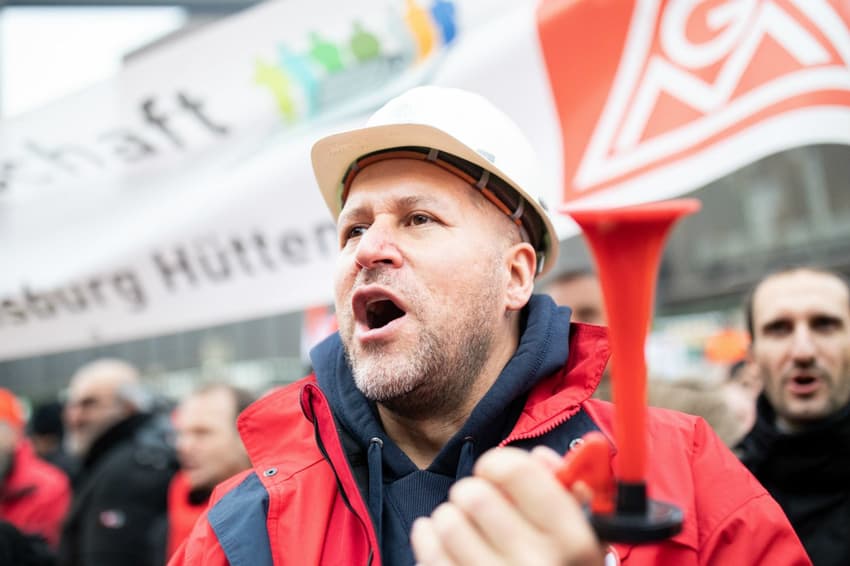Thousands of steel workers protest against German job cuts

Thousands of Thyssenkrupp steel workers in Germany on Tuesday protested against planned job cuts, accusing bosses at the struggling conglomerate of mismanagement after a failed merger bid with Tata steel.
Germany's powerful IG Metall union said 6,000 workers gathered at Thyssenkrupp's Steel Europe headquarters in Duisburg to vent their anger.
The group, which makes products from raw steel to submarines and car parts, has said it intends to axe at least 6,000 jobs globally, including 2,000 in the troubled steel division.
Armed with flares, flags and whistles in IG Metall's red-and-white colours, employees urged Thyssenkrupp to preserve jobs and invest more to give the steel unit a better chance in a challenging environment.
"We need fresh money. All we've had these past few years is cost-cutting programmes," steelworker Joerg Jakob told DPA news agency at the demo.
In a statement, Thyssenkrupp said it would flesh out its plan for the steel unit in coming weeks and has already committed to ploughing 570 million euros ($630 million) a year into the division.
But labour representatives are demanding nearly three times as much.
READ ALSO: Working in Germany: Should you join a trade union?

Employees in Duisburg. Photo: DPA
"Incompetent managers have run this company into the ground," Tekin Nasikkol, head of Thyssenkrupp's Steel Europe works council, told DPA.
Thyssenkrupp hit back, saying it believed "in the future of steel" and wanted to make its steel business competitive in the long run.
The European Commission's decision last June to block the merger with India's Tata Steel however meant that "far-reaching measures" were necessary to turn around the division.
"But the financial resources we make available must be commensurate with the expected returns," it stressed, adding that the company's room to manoeuvre was "limited".
Hit with the Tata setback, a damaging internal power struggle and a slowing global economy, Thyssenkrupp booked a net loss of €304 million in the year to September.
To help fund a painful restructuring, Thyssenkrupp is planning a sale or a stock market flotation of its highly profitable elevators arm.
And it has not ruled out further job losses among the group's 160,000 employees.
Comments
See Also
Germany's powerful IG Metall union said 6,000 workers gathered at Thyssenkrupp's Steel Europe headquarters in Duisburg to vent their anger.
The group, which makes products from raw steel to submarines and car parts, has said it intends to axe at least 6,000 jobs globally, including 2,000 in the troubled steel division.
Armed with flares, flags and whistles in IG Metall's red-and-white colours, employees urged Thyssenkrupp to preserve jobs and invest more to give the steel unit a better chance in a challenging environment.
"We need fresh money. All we've had these past few years is cost-cutting programmes," steelworker Joerg Jakob told DPA news agency at the demo.
In a statement, Thyssenkrupp said it would flesh out its plan for the steel unit in coming weeks and has already committed to ploughing 570 million euros ($630 million) a year into the division.
But labour representatives are demanding nearly three times as much.
READ ALSO: Working in Germany: Should you join a trade union?

Employees in Duisburg. Photo: DPA
"Incompetent managers have run this company into the ground," Tekin Nasikkol, head of Thyssenkrupp's Steel Europe works council, told DPA.
Thyssenkrupp hit back, saying it believed "in the future of steel" and wanted to make its steel business competitive in the long run.
The European Commission's decision last June to block the merger with India's Tata Steel however meant that "far-reaching measures" were necessary to turn around the division.
"But the financial resources we make available must be commensurate with the expected returns," it stressed, adding that the company's room to manoeuvre was "limited".
Hit with the Tata setback, a damaging internal power struggle and a slowing global economy, Thyssenkrupp booked a net loss of €304 million in the year to September.
To help fund a painful restructuring, Thyssenkrupp is planning a sale or a stock market flotation of its highly profitable elevators arm.
And it has not ruled out further job losses among the group's 160,000 employees.
Join the conversation in our comments section below. Share your own views and experience and if you have a question or suggestion for our journalists then email us at [email protected].
Please keep comments civil, constructive and on topic – and make sure to read our terms of use before getting involved.
Please log in here to leave a comment.